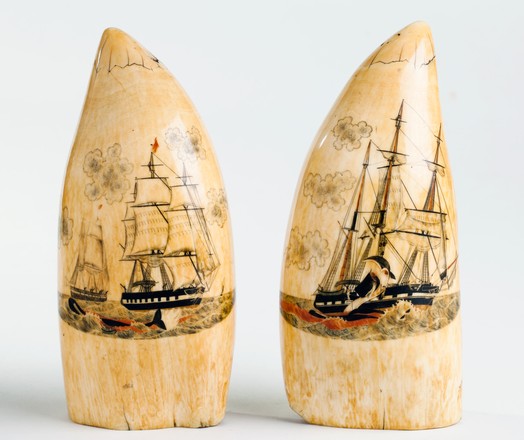Sperm whale's teeth scrimshaw
Artists unknown, c1800s
Ink on whale tooth
Bequest of Sir William Dixson, 1952
DR 40
Scrimshaw is the craft of carving pictures or patterns into bone, teeth, horn, shell or other suitable materials. While its origins are unknown, the technique became popular onboard whaling ships, where the tools, the materials and the time were readily at hand.
Scrimshaw features a wide range of images, often traced by pinpricking from books and journals. Especially common however are scenes of whaling and marine life. These examples show whalers at work. On one tooth, men in a longboat are harpooning a whale. On the other, a whale is being hauled onboard the ship, where its valuable blubber and skin will be stripped, or flensed.
Sperm whales in great plenty
The colony in NSW was a convenient base for whalers exploring and exploiting the southern seas. When the convict ships of the Third Fleet arrived in Sydney in 1791, five of the ships were whalers: Britannia, Mary Ann, Matilda, Active, and William and Ann.
Thomas Melville, captain of the Britannia, was astonished at the number of sperm whales he sighted in the waters just outside Sydney Harbour:
"Within three Leagues of the shore we saw Sperm Whales in great plenty: we sailed through different shoals of them, from twelve o’clock in the day, till after sunset, all round the Horizon, as far as I could see from the Masthead. In fact I saw a very great prospect in making our fishery upon this coast, and establishing a fishery here … I was determined as soon as I got in, and got clear of my live lumber to make all possible dispatch on the fishery of this coast".*
Whaling was one of Australia's first primary industries. Commercial whaling continued in Australian waters until 1978.
Footnotes
* Thomas Melville, letter to Mess Enderby & Sons, from Port Jackson, Sydney, 2 November 1791. MLMSS A322 p 520–21



 Back to list
Back to list